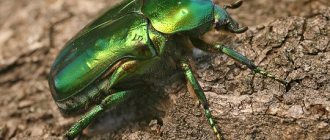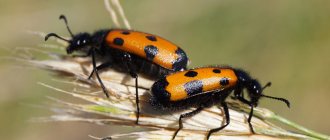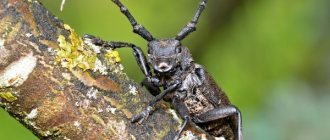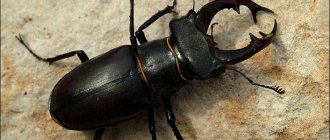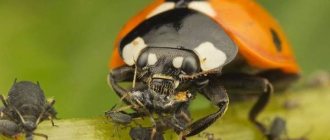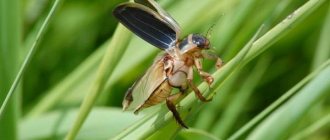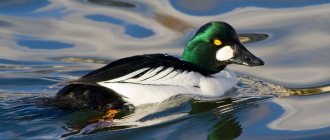Origin of the species
Scientists do not know for certain the origin of Coleoptera. Based on the findings of paleontologists, it can be assumed that their ancestors were cockroaches and protelytropters. Beetles appeared approximately 300 million years ago during the Carboniferous and Permian periods. There is no doubt that the aromorphosis of Coleoptera is inextricably linked with the evolution of large mammals, herbivorous dinosaurs.
Bronzovkas belong to the class of insects, the family of lamellar insects, numbering 4 thousand species, 33 of which live in Russia. The largest representative of the subfamily, which weighs up to 100 g, is the African goliath beetle.
Polymorphism is widespread within the species—the formation of different forms due to the influence of aboriginal living conditions. The common bronzer has 7 subspecies, differing in color tone, integument sculpture, habitat, degree and places of hair growth. The first description of the golden bronze was presented to the scientific community by Carl Linnaeus in 1758.
Natural enemies
Adult beetles are part of the diet of some birds. These include rollers, rooks, jackdaws, magpies, jays, orioles, and black-fronted shrikes. Of these, magpies, rollers and black-fronted shrikes especially often feed on beetles.
Of the Hymenoptera, the larvae of the golden bronze are parasitized by a number of species, Scolia fourspot and Scolia steppe. Having found the larva, the female Scolia paralyzes it with a sting injection into the abdominal nerve ganglion, after which she lays one egg on it. The Scolia larva that emerges feeds on the living but paralyzed beetle larva, starting with the least important vital organs. Of the dipterans, the larvae of the tachine fly Billaea pectinata parasitize.
Description of the Beetle
Cetonia aurata is Latin for metallic and golden beetle. Color is the main distinguishing feature of an insect, but there are two more features.
On the sides of the elytra there are cutouts through which the arthropod releases and raises well-developed wings. In this case, the elytra do not change location. The second feature is scaly spots on the thighs, abdomen, elytra, pronotum, and sides of the thorax.
Chitinous covers consist of several layers. On the rounded head, which passes into the prothorax, sensory organs are located. On the sides there are compound eyes, between them there are antennae that help to touch and smell. The palps on the lower jaw and lip are needed for touch and taste.
The structure of the limbs is determined by the lifestyle. To make it easier for the common bronze to dig the ground, there are teeth on the thickened tibiae of the front legs. The middle and hind legs are equipped with spurs.
What does it look like
The representative of the lamellar family looks like a beetle, measuring 1.3–2.3 cm in length and 0.8–1.1 cm in width. The oblong, rounded, short body shimmers with a changeable metallic tint. The predominant colors are emerald, golden green or bright green.
The large beetle has a head with a longitudinal keel, covered with whitish hairs, and slightly lowered. The widest part of the body is the pronotum. Between it and the elytra in the shape of an isosceles triangle there is a shield. The elytra themselves are marked with strokes and stripes.
Character and lifestyle
Bronzers are active exclusively during the daytime. They prefer sunny, warm weather. When the sun hides behind the clouds, they sit motionless on the plants. If it is damp and cloudy outside, they take cover under fallen leaves on the ground. They spend the night there.
How many months the beetles fly depends on the climatic features of the area. The longer the summer, the longer the activity remains. Despite their heavy weight, bronze birds fly well.
The fact that the fender liners remain pressed to the body reduces take-off time. This circumstance helps to avoid danger when meeting an enemy.
If there is a choice, they descend on a large flower to extract as much nectar as possible and gain strength to move to another plant.
Maneuverable beetles sometimes collide with an object in flight and fall belly up to the ground with a dull sound. They move their short legs for a long time until they manage to roll over. They spend most of their lives searching for food.
What does it eat?
The Golden Bronzefish feeds variedly. The diet after wintering includes tree sap, young leaves, and shoots. During flowering, the beetle drinks nectar, eats pollen, petals of flowers of fruit trees, berry bushes and herbaceous plants.
When the fruits are overripe, insects attack rowan, cherry, blackberry, viburnum, apricot, apple, and pear trees. They eat the seeds of umbrella plants. Vegetable crops are also not ignored. They especially like legumes, cabbage, and cereals.
Flowers they prefer are roses, irises, and peonies. They love to eat lilac flowers. The larvae, while in compost, litter of fallen leaves or rotten wood, eat plant debris.
Where does it live?
In Eurasia, the bronzeback is not found only in deserts. The beetle can be seen in the countries of Scandinavia, Europe, England, Asia Minor, Western and Central Asia. The insect is found not only on the mainland, but also on the islands of the Mediterranean Sea.
In Russia, the beetle's range extends from Lake Ladoga through Yekaterinburg, Novosibirsk to Lake Baikal. The distribution area includes the Amur region, southern Crimea, and the Caucasus.
Suitable biotopes are forest edges, meadows, forest-steppes. Rarely lives in dense forests, preferring open, well-lit areas.
In the mountainous areas of Transcaucasia and Central Asia it lives at an altitude of up to two thousand meters above sea level. In the northern regions it settles on the plains.
Reproduction
Mating and reproduction lasts the entire season, which lasts 2.5–4.5 months. Sensitive antennae help the male find the female secreting pheromones. Their tips are equipped with plates that open in the form of a fan.
A fertilized female lays up to 20 eggs in compost heaps, anthills, rotting leaves or rotten stumps.
Larva
Scientists still have not figured out why ants do not touch alien offspring. According to one hypothesis, it is due to the repulsive smell.
Two weeks later, voracious larvae with powerful jaws appear. They tirelessly pass large volumes of plant debris through themselves, without using the undeveloped small legs. They move on their back, contracting and relaxing the muscles of the rollers.
The larva looks like this:
- cream-colored body 4–6 cm long, bent in an arch;
- the body tapers towards the head;
- each jaw has four teeth;
- legs are small;
- antennae - thick and short;
- two rows of spines surround the anus.
By the time of wintering, due to rapid growth and three periods of maturation, the larvae have time to molt several times. The following year, pupae are formed - the last stage before the formation of the adult.
Doll
Life cycle
The stages of egg, larvae, pupae, and adult go through the stages of the golden bronze in most cases in one year, in the northern regions - in two. From eggs laid in summer, larvae are formed, which intensively feed on organic matter until winter.
When they grow to 6 cm, pupation occurs. The larva makes a strong false cocoon from dust, excrement, soil, and fastens it with its own secretion. Externally, the pupa resembles an adult insect with a head tucked under the chest and short wings.
After two weeks, the pupa turns into an imago, hibernates until spring in a shelter or comes to the surface. With a two-year life cycle, the life expectancy of the imago is from six months to 12 months.
Natural enemies
Bronzewolves are eaten by black-headed shrikes, corvids (especially magpies), and orioles. In winter, tearing apart anthills in search of food, foxes and badgers find larvae.
Don't mind eating bugs:
- moles;
- hedgehogs;
- weasels, ferrets, martens;
- lizards;
- frogs.
Scolia flies, tachina flies, and ticks parasitize the larvae. Wasps are especially dangerous. They paralyze the victim by piercing the nerve responsible for movement with their sting. Then they drag it into a hole and lay eggs on the half-dead carcass. This is how Scolia provides food supplies for its offspring.
Wintering
Male golden bronzes die immediately after mating, females die after laying eggs. Bronze beetles mainly overwinter at the stage of pupae and adult beetles in cocoons in the same places where the female laid her eggs. After warming, already formed individuals come to the surface.
But sometimes the Common Bronzewort in the adult stage emerges from its shelters in the fall. The beetle leads an active lifestyle, and with the onset of cold weather it takes refuge in rotten stumps, tree hollows, forest litter or compost heaps. In spring, such insects are the first to wake up.
Habitat
Bronzewort can be found almost throughout Eurasia; it does not live only in mountainous and desert areas. Depending on the species, the habitat is slightly different. For example, the golden one is distributed from the south of Scandinavia to the Balkans, on the coasts of the Mediterranean Sea, in Asia Minor, and Tajikistan.
The smooth bronzeback is considered an endangered species; it lives in temperate climates, most often settling in old gardens and forests. Bronzovka stinking prefers areas with warm climates.
In the photo the bronze is smelly
The habitat of the bronze is very large, but there are places where it does not live. For example, it does not like desert areas, does not live in the northern part of the Crimean peninsula, in steppe spaces.
In Russia, the northern border of the range runs along the Karelian Isthmus, the eastern border is on Lake Baikal, and from the south the range is limited by the Crimea and the Caucasus. Due to the fact that the bronze beetle is a non-migratory insect, and its larvae must feed on woody vegetation, it is found only in areas with bushes and trees.
Golden can be found in semi-deserts and deserts, but only in river valleys, where there is the growth it needs. Bronzovka prefers open, light areas - forest edges, plots, clearings, meadows. Sometimes they are also found in the forest - they fly deep into the forest for the sake of the sap flowing from the trees, which some species primarily feed on.
Meaning for humans
People's attitude towards golden bronze is ambiguous. The larvae do not harm green plants and increase soil fertility. During the growth process, they release vermicompost thousands of times more than their own weight and the benefits they bring are comparable to earthworms.
Bronze larvae are often confused with beetles, but they have significant differences. The cockchafer larva has longer legs, a more powerful jaw, and a larger head. Bronze is more hairy.
If we talk about adult insects, their harm consists of eating shoots and young leaves, stamens, stigmas, pollen, core and petals of flowers. The damage caused cannot be considered significant. Proof of this is the absence of insecticidal agents aimed at destroying the species.
To please children, some adults keep golden bronzes at home. It is not difficult to create an insectarium suitable for beetles. You will need a cage or a tall aquarium with a volume of at least 10 liters with a lid.
The dwelling is equipped by lining the bottom with a 20-centimeter layer of turf-peat substrate. Sand, fallen leaves, and wood dust are added to it. They decorate with driftwood, stones, and plant unpretentious plants (ficus, wax ivy).
Keeping conditions are room temperature, additional lighting with fluorescent lamps, moistening the substrate and feeding. In summer, lilac flowers, peonies, and roses are added to the winter diet, consisting of slices of fruits, vegetables and honey.
Nutrition
Bronze wrens feed on different foods, depending on the species. But these are always different parts of plants. For example, the stinking bronze beetle feeds on flower pollen, while its larvae eat roots.
The smooth one loves the juice of overripe fruits, and the green one eats the whole flowers. The flowers of wild and cultivated plants and trees are eaten. Bronzeworts feed on leaves and thin bark, and drink tree sap.
Due to the fact that it happily eats flowers and young shoots of such cultivated trees as apple and pear trees, it is considered a pest among gardeners. People fight any pest, and the bronze beetle - to kill the beetle, various preparations are buried in the soil under fruit trees.
Since the bronze fly spends the night in the ground, the poison will affect it, but will not harm beneficial insects, such as bees. In the wild, bronzes most often eat the flowers of knotweed, mountain ash, sorrel, thorns, peas, thistles, sage and many other plants.
In gardens and vegetable gardens, rose hips, apple trees, pears, beets, carrots, mustard, rye, and corn suffer from them. Bronzovka also loves cultivated flowers - lilacs, irises, roses, dahlias and even home orchids. Beetles suck out plant sap and eat stamens and pistils. On young shoots they like to eat the bark and edges of leaves.
Golden bronze in the Red Book
The beetle Cetonia aurata was listed in the Red Book of the Moscow Region in 2001 and remains there to this day despite its increasing numbers in some years. The golden bronze was assigned category 3, “vulnerable species in Moscow.”
Unfavorable factors:
- reducing the area of biotopes for adult insects due to development and mowing of meadows;
- removal of leaf litter and old dead trees in park areas;
- catching by children because of their decorative appearance.
Measures to increase the number of the species are aimed at limiting sanitary clearings, preserving meadows with flowering plants, and leaf litter in forests outside recreation areas for city residents.
Smelly
Other names: spotted deer or fetid deer. A small shiny black beetle. Body size up to 13 mm. There are many small white spots on the elytra. The body is covered with white dense bristles. Lives in warm regions, including southern Russia.
An agricultural pest, as the larvae eat plant roots. The adult feeds on pollen. Summer begins in May.
Types of bronzes
Interesting facts about insects
Amazing facts about the common bronzeweed:
- beetles fly from place to place, so chemicals cannot exterminate them;
- The bronco is distinguished from the green pied by the Latin letter V on the metanotum;
- the bright emerald color with a metallic tint is formed due to the ability of the integument to scatter light;
- brightness and shine not only attract individuals of the opposite sex, but also protects them from enemies, concealing the outlines of the body;
- the frightened bronze, in self-defense, releases a sharp-smelling liquid.
The formation of the floor is influenced by the ambient temperature. In hot weather, more females emerge from the cocoons; in cool weather, more males emerge. Among bronze beetles, genetic changes are common, in which beetles of mixed sexes appear with male and female characteristics on two halves of the body.
Harm from larvae
After fertilization, the female lays one egg at a time (rarely 2-3) in the soil or old tree stumps. The bronze larva appears after 2-3 weeks. For 2 months they feed on dead roots or other plant debris, which at that time are decomposing in the soil.
At this stage of development, the pest is not dangerous, but even useful. The larva constantly eats, crushing plant debris that is already partially destroyed by putrefactive processes. In this way, it accelerates the decomposition of solid particles, which would remain intact for a long time.
Golden turtle
The “golden turtle” can rightfully be called the most beautiful beetle in the world. It looks like a jewel come to life - you could easily imagine it as a pendant on a pendant.
A very interesting fact about this “miracle of nature” is that the golden turtle can change its color depending on the level of humidity, stress or in case of death.
The “Golden Turtle” is a distant relative of the Colorado potato beetle, which is hated by all owners of gardens and summer cottages.
This beautiful bug is quite small - its size does not exceed 5-7 mm. This insect is widespread in North America.
Zlatka
The goldenrod is a beetle with a very beautiful bright green metallic color, which is how it got its name. They even make jewelry from these beetles, and the British call the golden beetle nothing more than a jewel beetle, which translates as “jewelry beetle.”
Zlatki are distributed mainly in southern Asia, but they can also be found in Russia - in the Primorsky and Khabarovsk territories. The favorite habitats of borers are ash and walnut.
Most often, borers appear in June, and their lifespan does not exceed three weeks. These beetles can cause damage to trees, but their numbers are kept in check by predators and parasites.
Ways to fight
Bronzeweed cannot cause much damage to the flowers of fruit trees, but it spoils young shoots, leaves and fruits. It is an unwelcome guest on the site because it gnaws holes and holes in parts of plants, after which the damaged areas become sore and dry out. Flower growers hate this beetle even more. How much work was spent to grow beautiful roses and phloxes, and a voracious pest consumed all this beauty as food.
You cannot spray flowering trees with poisons: you will kill the beneficial insects that pollinate the garden and will be left completely without a harvest. To combat the pest, you need to use other methods. At night, beetles usually burrow into the ground. To destroy them, bury Medvetox or a similar drug to a depth of 3–5 cm, and there it will not harm beneficial insects.
Carefully examine peat and manure heaps, because there may be larvae there. If you notice pests, apply “Bazudin” in granules of 15 g per 10 m2 to these places. If you use similar products (“Thunder”, “Pochin”, etc.), read the dosage in the instructions. Spray the plantings with “liquid smoke” or a solution of green soap. If your trees have a lot of broncos, spread a film on the ground and shake the crown. Please note that beetles fly well in sunny weather, so spray the trees with water first. Collect fallen insects in a bag and burn them or fill them with water. Beetles can be collected from ornamental low plants by hand. And don’t forget that these pests are rarely found in well-kept gardens: they like rotten wood, hollows and cracks. Put your plantings in order so that beetles do not have a place to conveniently spend the night and lay eggs. Destroy diseased trees and cover up minor damage. Bronze birds are a common food for carrion crows, magpies, rooks, jackdaws, and rollers. It’s good if these birds fly to your site.
Fanous
Fan whisker beetles are known precisely for their gorgeous mustache, consisting of at least twenty segments and resembling thickly painted eyelashes.
They are so rare that they are one of the least studied representatives of their species today. Fanwhiskers live in Australia and can only grow up to 25 millimeters.
Whiskers serve males to pick up pheromones from females of their species, and to understand how ready the female is for mating. The number of male fanwhiskers significantly exceeds the number of females, so they often have to fight among themselves for a fertile individual.
Brazilian bigtooth lumberjack
One of the largest beetles in the world - the size of the largest individual of the Brazilian bigtooth woodcutter is 17.8 cm. It lives in the forests of Colombia, Brazil, Peru, Ecuador and Colombia.
This insect spends up to ten years in the larval stage, but the life of an adult woodcutter, alas, is limited to several months. Thanks to its very impressive size and beautiful colors, this beetle is a dream for any collector.
Dried specimens are considered an excellent interior decoration. Beetles are very expensive, but this does not bother exotic lovers - they like the opportunity to frame this rare and beautiful insect, and they are ready to pay any money for it.
Fruited nut
This is a very small bug with a very long proboscis, which is also often called the nut weevil. The nut fruit can be found in the European part of Russia and the Caucasus. The beetle's body is completely covered in brownish-yellow hairs, making it look like a miniature version of a sparrow.
Fruit veins emerge at the end of spring, when the weather is warm enough. They feed on leaves, hazel fruits, hazelnuts and acorns. Weevil larvae eat the nut kernel and fill its cavity with excrement. They are considered pests and are actively destroyed by owners of summer cottages.
